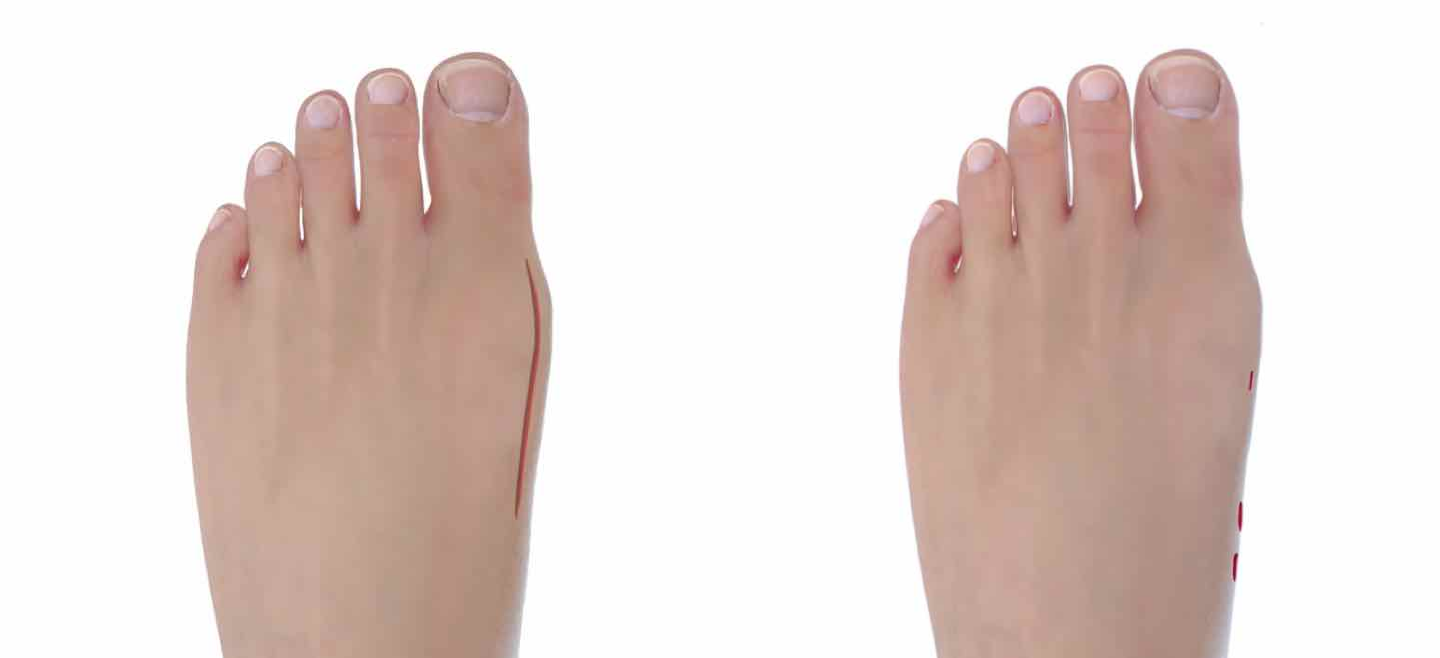
The Science Behind Successful Outcomes
Numerous claims support the Arthrex Minimally Invasive Bunionectomy’s effectiveness
More than 3 million bunion cases are recorded in the US each year. Many bunions are mild, pain-free, and never require treatment (or can be soothed with roomy shoes and short-term remedies like moleskin or bunion correction sleeves). However, these options cannot correct the underlying reason for the characteristic bunion “bump,” which is caused when the bones of the big toe rotate out of alignment. This deformity, called hallux valgus, can progress and lead to pain and other toe conditions.
If you find that your bunions are impacting your daily life, such as causing pain or making your favorite activities uncomfortable, there’s a lot to consider, including:
• What are the treatment options for a severe bunion?
• When is surgical treatment for a bunion appropriate?
• What is the experience of surgical treatment for a bunion like?
• Will I be in pain after bunion surgery?
• What will my recovery be like after bunion surgery?
• What complications could occur if I don’t treat my bunion?
Further complicating the decision, there are hundreds of techniques for correcting bunions,¹ and they vary widely. So which should you consider?
Scientific Support for the Arthrex Bunionectomy
One important element to explore when researching surgical bunion correction is the science behind a procedure’s claims. Some procedures do not have the same outcomes as others.
The Arthrex Minimally Invasive Bunionectomy realigns the bony structures of your toe through small incisions on the side of the foot. Special training is available for surgeons to gain experience with the Arthrex Bunionectomy’s specialized instruments, which achieve correction without joint fusion or excessive hardware.
The less invasive nature and specially designed equipment of the Arthrex Bunionectomy have benefits for patients including a faster recovery time,²𝄒³ less pain and swelling,²,⁴ and smaller scars² than other options.
Let’s take a look at some of the claims that support the success stories of the Arthrex Bunionectomy.
Glossary of Terms
Here are some terms that are commonly used when discussing bunion treatment.
- 1st MTP: The first metatarsophalangeal joint; located at the base of the big toe
- Osteotomy: A surgery in which one or more bones are cut
- Open/Scarf Osteotomy: Traditional bunion procedure that requires a large incision
- Chevron/Akin Osteotomy: A less invasive bunion correction procedure that requires a smaller incision
Claim: The Arthrex Bunionectomy Has a Faster Recovery Time Than Other Procedures
In a 2018 study, Lai et al compared the results of chevron/Akin and open/scarf osteotomies to explore whether the newer, minimally invasive chevron/Akin procedure has outcomes comparable to open procedures.³
While they achieve correction, open bunion procedures have significant drawbacks too, particularly during recovery. Over the years, there have been several new bunion correction procedures developed with the aim of reducing these negative outcomes.
In this study,³ researchers wanted to see whether the chevron/Akin procedure reduced these short-term drawbacks while keeping the positive elements of the open surgery. They did this by comparing 29 feet that underwent the percutaneous chevron/Akin procedure with 58 feet that underwent open/scarf procedures.
Then, they compared results from each group using several measurement scales that assess pain and patient experience.
Patients who underwent the minimally invasive procedure reported less pain during the early postoperative period, as well as no wound complications, both of which helped them recover faster.³ On the other hand, traditional hallux valgus correction may cause delayed recovery “as a result of postoperative pain, swelling, wound infection, and stiffness.”³
Another study, conducted by Lee et al in 2017,² studied 50 patients with the following criteria:
• Older than 30 years, with a painful bunion
• Didn’t find success with conservative treatments for a period of 3 months or longer
• Had a moderate to severe hallux valgus deformity as seen on x-rays
• Didn’t have a musculoskeletal disease, joint disease, or prior surgery on their foot
Like the first study, patients underwent a minimally invasive bunion correction procedure. They were immediately able to bear full weight using a surgical shoe, as tolerated, and using crutches as needed. After that, they could transition into sneakers.
These patients’ bunion corrections were comparable to the more invasive procedure, but they reported higher satisfaction and less pain after surgery.
Read Sammy’s story about getting back to her favorite activities quickly after undergoing the Arthrex Bunionectomy.
Claim: The Arthrex Bunionectomy Results in Less Pain, Swelling, and Stiffness Than Other Procedures
How you feel in the weeks after surgery is an important element to consider when discussing whether to undergo surgery to correct your bunion. No one wants to be in more pain than is necessary!
Several studies have shown that minimally invasive procedures like the Arthrex Bunionectomy result in less pain, swelling, and stiffness than other available bunion procedures.²⁻⁵
Lee et al highlighted significantly less pain in the first 6 weeks after surgery as a major difference among the cases they studied.² Lai et al also noted this benefit in their 2018 study.³
In addition to pain, the amount of soft-tissue disruption from the long incisions required in open bunion surgeries can lead to swelling and stiffness in the toe. Meanwhile, the Arthrex Minimally Invasive Bunionectomy requires just a few tiny incisions, which protects the vascular structures of your foot, promoting blood flow to the area and reducing the swelling and stiffness associated with more invasive techniques.⁴𝄒⁵
In their 2018 study of minimally invasive versus open bunion corrections, Lai et al noted less pain and a reduced risk of wound complications after the minimally invasive bunion surgeries.³
In 2015, Kheir et al reviewed a series of 30 minimally invasive cases of calcaneal osteotomy, a heel procedure that corrects a foot and ankle deformity (in the same way an osteotomy is performed to correct the hallux valgus deformity). They found minimal swelling and stiffness.⁴
Claim: Arthrex Bunionectomy Scars Are Much Smaller Than Other Procedures
Minimally invasive bunion surgery was introduced in the 1980s to help combat the limitations of open procedures. In the 40-plus years since, surgeons have worked to improve upon these earlier options, aiming to match the level of fixation of traditional procedures while providing a cosmetic option.
Today, the Arthrex Minimally Invasive Bunionectomy’s tiny pinhole incisions result in barely noticeable scars that, for many patients, fade over time.
In their 2019 article, Frigg et al looked at the length of incisions required in open/scarf versus chevron/Akin osteotomy procedures. Results showed the scars were “significantly” smaller after minimally invasive chevron/Akin procedures than after open/scarf procedures (an average of 1.2 cm vs 5 cm).⁵
Lee et al’s 2017 research also noted approximately 4 times smaller scars in the patients who underwent the minimally invasive procedure.²

When you’re exploring surgery for a painful bunion, these are just a few of the important elements to keep in mind. A surgeon who has trained in the Arthrex Minimally Invasive Bunionectomy will be able to discuss the procedure with you and answer any additional questions you may have.
Considering bunion surgery? Download this guide with helpful questions to ask your doctor.
References
- Jeuken RM, Schotanus MG, Kort NP, Deenik A, Jong B, Hendrickx RP. Long-term follow-up of a randomized controlled trial comparing scarf to chevron osteotomy in hallux valgus correction. Foot Ankle Int. 2016;37(7):687-695. doi:10.1177/10711007166395742
- Lee M, Walsh J, Smith MM, Ling J, Wines A, Lam P. Hallux valgus correction comparing per cutaneous chevron/Akin (PECA) and open scarf/Akin osteotomies. Foot Ankle Int. 2017;38(8):838-846. doi:10.1177/10711007177049413
- Lai MC, Rikhraj IS, Woo YL, Yeo W, Ng YCS, Koo K. Clinical and radiological outcomes comparing percutaneous chevron-Akin osteotomies vs open scarf-Akin osteotomies for hallux valgus. Foot Ankle Int. 2018;39(3):311-317. doi:10.1177/10711007177452824
- Kheir E, Borse V, Sharpe J, Lavalette D, Farndon M. Medial displacement calcaneal osteotomy using minimally invasive technique. Foot Ankle Int. 2015;36(3):248-252. doi:10.1177/10711007145571545
- Frigg A, Zaugg S, Maquieira G, Pellegrino A. Stiffness and range of motion after minimally invasive chevron-Akin and open scarf-Akin procedures. Foot Ankle Int. 2019;40(5):515-525. doi:10.1177/1071100718818



